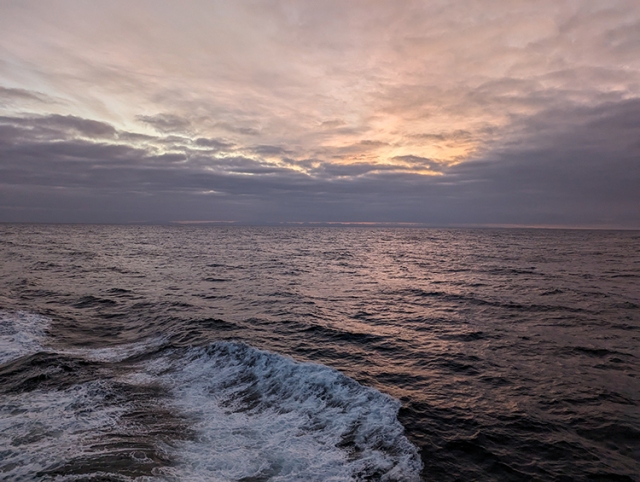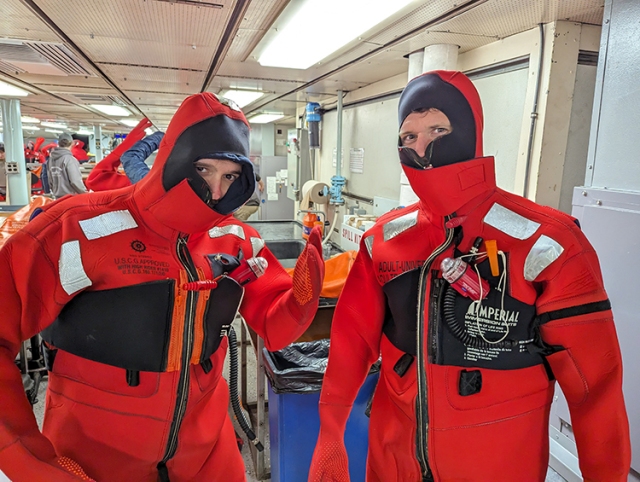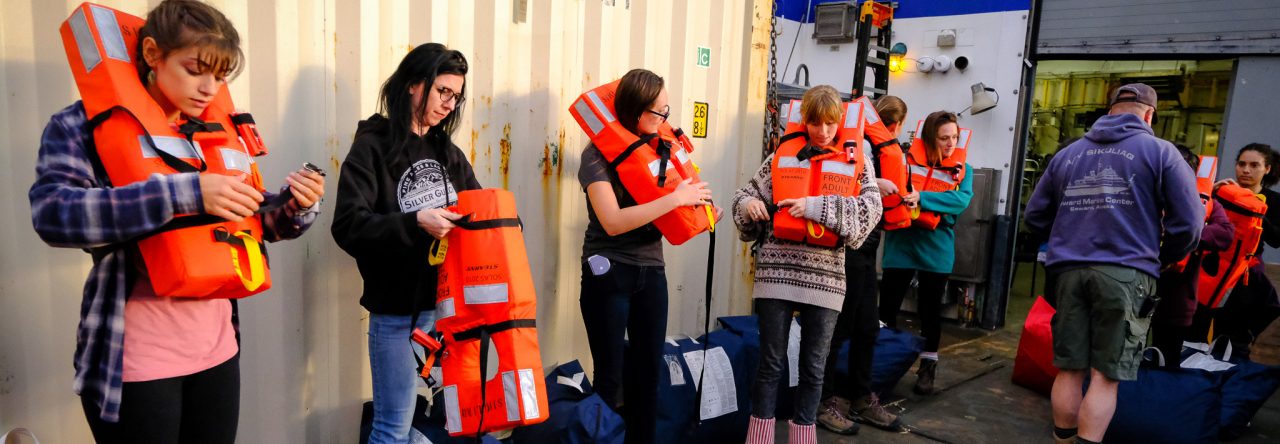
Science, Technology, Engineering, and Mathematics Student Experiences Aboard Ships (STEMSEAS) is a multiyear project funded by the National Science Foundation (NSF Grants 1701174 and 1701168) to provide students with inspirational opportunities to experience life on an oceanic research vessel. STEMSEAS leverages research vessel “transits” (voyages where the vessel is moving between scientific expeditions in different parts of the world) to utilize ship resources for short-term student research experiences. John Lewis of Indiana University of Pennsylvania is PI on the initiative, and co-PI Sharon Cooper manages the project from Columbia University.
For example, if a research expedition studying geomorphology offshore of La Jolla concludes, but then the next research expedition (studying trench sediments in Alaska) doesn’t start for two weeks, the ship has to get from California to Alaska. To make good use of the ship’s route and capabilities, STEMSEAS places a cohort of students with two faculty members and two graduate assistants on board. The grant pays for all participants’ travel to the point of embarkation, and then home from the point of disembarkation. The mentor team orchestrates small-scale activities designed to teach the students basic principles of oceanography, but much of the learning is about shipboard life and the routines of a scientific research vessel. Bunking a narrow berth, the routine of dining aboard, and safe commuting through the moving vessel are all skills that those onboard pick up immediately. The ship’s crew led the participants in safety drill and the donning of emergency immersion suits.

The current transit is from Seattle, Washington, to Honolulu, Hawaii. The ship is the R/V Thompson, a vessel owned by the United States Navy but operated by the University of Washington. Instead of students on board, the STEMSEAS team is entirely comprised of community college science educators. The team hails from all parts of the United States, from Virginia, Maryland, and Illinois to Texas, Utah, Arizona, and a healthy cohort from western Washington.
Marina Halverson, a professor at Seattle Central College, serves as Chief Scientist of this unique mission. “The goal of this transit is to provide potential mentors with an experience that they can share with students in order to get more student participation from two-year colleges. We also want to build confidence in our two-year college faculty to be leaders on future student cruises.”
Other members of the leadership team include Kaatje Kraft (Whatcom Community College), Dana Vukajlovich (Bellevue College), Nicole Murray (University of Illinois – Urbana Champaign; PhD student), and Sian Proctor (Maricopa Community Colleges).
“Dana, Marina, and I all talked about this idea with Sharon a number of years ago,” Kraft said. “I’m very elated to see it finally happening.”
Rebecca Sperry of Salt Lake Community College is one of the participants. She is here, “because I want to be out on the open ocean and see what it feels like. This is an amazing opportunity for students, and I’m keen to learn more about it, so I can be a mentor next time. When I was young, I considered marine biology and geology, but went off in a different direction. This is fulfilling a dream of mine from a long time ago,” she says.
“I would like to be a mentor for a STEMSEAS cruise, particularly for students underrepresented in the geosciences,” says Roman de Jesus of Fullerton College. “I would also like to encourage my students to pursue opportunities in STEMSEAS. Having had this experience firsthand, I’m ground-truthing what they would experience. I think it’s a really good experience for undergraduates.”
“I really want to do a BIPOC or a queer cruise, one big enough that students feel safe on it,” says MB Ramirez of North Seattle College.
This is not the first STEMSEAS cruise aimed specifically at faculty. In January 2023, there was an HBCU faculty cruise. HBCUs are Historically Black Colleges and Universities. As with the current two-year college faculty cruise, the goal of bringing faculty from HBCUs aboard the ship was to be deliberate about the overall STEMSEAS goal of expanding participation in oceanography through targeted recruitment.

The current mission has been underway for less than 24 hours, but already numerous exciting developments have taken place. The Thompson cruised overnight through the Straight of Juan de Fuca, and emerged into the open Pacific Ocean early this morning. Swells in the ocean were immediately felt throughout the ship. Several members of the #STEMseas2YC crew felt queasy with the rolling motion, but the leadership team had prepared us well, and doubtless many more would have felt lousy had we not taken our anti-nausea medication. Weather has been good, and a flock of gulls has been following the ship through the choppy seas. An original straight-line route was abandoned due to a large storm in the north Pacific, so in an attempt to avoid the biggest waves, the Thompson is diverting south to the Oregon/California border before turning west.
Indoors, STEMseas2YC participants engaged in icebreaker activities that emphasized the breadth of backgrounds and experience levels in the cohort. They also completed an active learning exercise designed to demonstrate how science strings together stories from incomplete data sets, emphasizing how the overarching story can change when new data are revealed. On deck, the participants estimated wave period and wave height, and scanned the horizon for whales.
A new STEMSEAS proposal has been submitted to NSF. “We’re building on the success of the first round,” says Halverson. “We want to incorporate more two-year college faculty going forward. We are going to be really intentional about that.”

Pingback: On expertise (or the lack thereof) and the Glacial geology of Discovery Park, Seattle – STEMSEAS
Pingback: Glacial geology of Discovery Park, Seattle - Mountain Beltway – The Insight Post
Pingback: Celebrating the Courageous Leadership of California Community Colleges | Sonya Christian's Blog